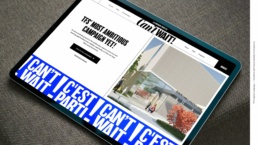Imagine this marketing scenario: you’ve been asked to create a campaign to reach a target audience in an industry with which you have no connection–and you have no budget to do it.
I can tell you from experience–that’s a daunting marketing mission. But I can also tell you it’s not impossible, either.
Curious Public gave me the honour of launching our now-established James Bullbrook Memorial Scholarship (JBMS) back in 2023. Curious Public created this scholarship in honour of our dearly departed colleague, James Bullbrook, to give financial support to one Canadian skateboarder each year so they can attend Woodward Skateboarding Camp in Pennsylvania.
When we were planning the launch, Curious Public didn’t have any skateboarders in its networks or online following. Look, we’re a marketing and communications agency, and not exactly known for our Ollies. How was I supposed to reach this audience if we didn’t know it? And how could I reach that audience with no budget? (Thanks, Lloyd)
I was in a real marketing pickle! So, how is it that JBMS is now thriving in its third year?!
Read on, and I’ll tell you how I did it in five steps.
Step One: Tell a Great Story
Don’t underestimate this foundational element in your next campaign. It doesn’t matter if you have a Coca-Cola-sized marketing budget; if you’re not telling a great story, you’re not going to earn anyone’s attention.
For us, the JBMS campaign wasn’t about a scholarship; it was about purpose and emotional connection. The campaign’s story centred around a father’s unwavering support, a son’s passion, and a lasting legacy—honouring James by helping young Canadian skateboarders and their families experience the bond he and Richie enjoyed at Camp Woodward. We used this true and authentic story to anchor all our communications, from landing pages to social media posts to outreach messages. The story was compelling because it was authentic.
Step Two: Do Community Outreach
I learned how powerful communities were when I led the Canada Strong initiative to support Canadian small businesses during the COVID-19 pandemic. Canada Strong partnered with more than 24 businesses. The campaign earned a 400% increase in online engagement, $7,000+ in donations to support small businesses, and still gets industry recognition to this day.
I applied what I’d learned from Canada Strong to our community outreach for JBMS. The tactics included:
- Create a media kit: We provided social media and email content, and print material to make it easy for other organizations to share our message. This minimized their effort and ensured a consistent message.
- Message potential partners: We combed the internet for potential partners in the Canadian skateboarding world and sent emails and direct messages (DMs) on social media. DMs yielded far more responses than emails. Don’t underestimate the gatekeeping power of a social media manager!
- Build relationships: We thanked every organization that supported us and kept them updated on the campaign’s progress. Publicly acknowledging them in our promotions strengthened these connections.
- Put in the time: Community outreach needs hands-on work–especially if you have a limited budget. But it pays off, proving how valuable a personalized approach really is. We reached out to 60+ organizations in year one–about two dozen engaged with us and promoted the campaign on social media. We focused on the relationship with engaged organizations and started seeing larger industry organizations reshare our message in year two.
Step 3: Choose the Right Platforms
It’s critical to understand where your audience spends their time. Instagram became our primary focus for promoting JBMS. It was the platform where skateboarders and their communities were most active, and the nature of Instagram allows content to be discovered by new audiences—especially Reels. We used Facebook to help us reach non-profit skateboard organizations and LinkedIn to tap into our professional network. It became clear that Instagram drove most of our engagement and awareness with potential applicants during year one of the campaign.
Step 4: Measure Your Growth and Impact
You can’t improve what you don’t track. Define what success looks like and set goals for your campaign. Measuring results during and after the campaign ends will show you what’s working, what’s not, and where to make changes.
We beat our modest target for JBMS applications in year one; our target was three, we got seven. The total addressable market size gave us context when setting our target; knowing there aren’t a lot of Canadian skaters going to Camp Woodward (less than 100) helped frame realistic expectations. We more than doubled the number of applicants in year two and got attention from large organizations in the skateboarding community, like Skateboard Canada Magazine. This led to increased social media engagement and reach, as well as a 33% increase in traffic from Instagram, 27% increase in referral traffic including industry website referrals, and a 31% increase in organic search.
Step 5: Turn Your Audience into Advocates
A successful campaign doesn’t only attract people–it keeps them engaged. When people feel connected, they help spread your message.
The scholarship recipients are one of the key factors behind the growth of JBMS. The recipients became part of the campaign’s story helping us reach deeper into the skateboarding community. We asked recipients for photos and videos of their time at Woodward and they agreed to virtual interviews that we turned into reusable blog and social media pieces. The recipients’ involvement created new content opportunities and helped amplify our message to their networks. Recipients continue to engage and share the campaign each year because they had an incredible time and want to share their gratitude and experience with others.
No Budget, No Problem
To execute a successful campaign without a budget isn’t easy, but it is possible. You can achieve meaningful results by focusing on storytelling, community outreach, and strategic platform use. The JBMS campaign is proof that with creativity and persistence, you can break into new industries and reach new audiences—even when the odds are against you.
So, if you’re feeling daunted by a lack of resources, remember: it’s not about what you don’t have, it’s about how you use what you do.
Need help with your next campaign? We’d love to offer our support. Email us at info@curiouspublic.com, and we’d be happy to start a conversation.
Emma Earley
Senior Consultant, Digital Media at Curious Public.
Related Posts
February 5, 2025
TFS – Canada’s International School – Launches a Campaign that Dares to be Hopeful
0 Comments6 Minutes


